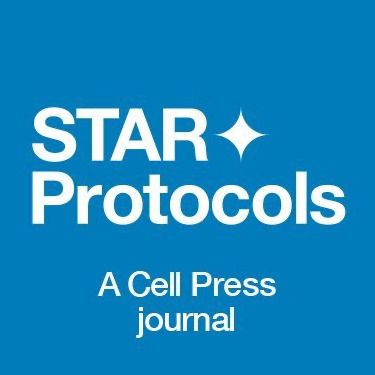
Protocol to establish rice root aphid colonies and experiments in greenhouse settings #protocol #starprotocols #cellpress
23.11.2025 20:26 — 👍 0 🔁 0 💬 0 📌 0@cp-starprotocols.bsky.social

Protocol to establish rice root aphid colonies and experiments in greenhouse settings #protocol #starprotocols #cellpress
23.11.2025 20:26 — 👍 0 🔁 0 💬 0 📌 0
Protocol for the enhanced analysis of electrophysiological data from high-density multi-electrode arrays with nicespike and spikeNburst #protocol #starprotocols #cellpress
23.11.2025 16:09 — 👍 0 🔁 0 💬 0 📌 0
Protocol for the expression, purification, and biochemical characterization of the innate immune sensor MDA5 #protocol #starprotocols #cellpress
22.11.2025 20:26 — 👍 0 🔁 0 💬 0 📌 0
Protocol combining RNA interference and regeneration assays in planarian embryos #protocol #starprotocols #cellpress
22.11.2025 16:08 — 👍 0 🔁 0 💬 0 📌 0
Protocol for imaging-based quantification of RNAPII clearance during transcription-coupled DNA repair #protocol #starprotocols #cellpress
21.11.2025 22:08 — 👍 0 🔁 0 💬 0 📌 0
Protocol to investigate gene expression heterogeneity in cyanobacteria using mRNA CARD-FISH #protocol #starprotocols #cellpress
21.11.2025 20:26 — 👍 0 🔁 0 💬 0 📌 0
Protocol to clone unknown flanking genomic region using SWPOP-PCR for genome walking #protocol #starprotocols #cellpress
21.11.2025 16:09 — 👍 0 🔁 0 💬 0 📌 0
Protocol to study human Kv1.2 potassium channel pathogenic sequence variants using two-electrode voltage-clamp technique #protocol #starprotocols #cellpress
20.11.2025 22:08 — 👍 0 🔁 0 💬 0 📌 0
Protocol for investigating mitochondrial structure, function, and metabolism in human cervical cancer cells #protocol #starprotocols #cellpress
20.11.2025 20:26 — 👍 0 🔁 0 💬 0 📌 0
Protocol to measure insulin secretion dynamics from single mouse islets using a microfluidic fluorescence anisotropy immunoassay #protocol #starprotocols #cellpress
20.11.2025 16:08 — 👍 0 🔁 0 💬 0 📌 0
Protocol for fabricating a starfish-inspired magnetoelastic generator array #protocol #starprotocols #cellpress
19.11.2025 22:09 — 👍 0 🔁 0 💬 0 📌 0
Protocol for a mouse tubuloid model of myoglobinuric acute kidney injury #protocol #starprotocols #cellpress
19.11.2025 20:26 — 👍 0 🔁 0 💬 0 📌 0
Bridging mesoscopic and microscopic scales in multiple sclerosis: Post mortem brain block multi-contrast 9.4T MRI and histology quantification #protocol #starprotocols #cellpress
19.11.2025 16:09 — 👍 0 🔁 0 💬 0 📌 0
Protocol for culturing olfactory epithelium organoids supporting neuronal differentiation #protocol #starprotocols #cellpress
18.11.2025 22:09 — 👍 0 🔁 0 💬 0 📌 0
Protocol for dynamic high-throughput cell death screening of primary phagocytes following microplastic and nanoplastic exposure #protocol #starprotocols #cellpress
18.11.2025 20:27 — 👍 0 🔁 0 💬 0 📌 0
Protocol for genetic discovery and fine-mapping of multivariate latent factors from high-dimensional traits #protocol #starprotocols #cellpress
18.11.2025 16:09 — 👍 0 🔁 0 💬 0 📌 0
Protocol for quantifying the thickness and puncture resistance properties of solitary bee cocoons using Osmia lignaria as a model #protocol #starprotocols #cellpress
17.11.2025 22:08 — 👍 0 🔁 0 💬 0 📌 0
Protocol for RNA-seq library preparation from low-volume total RNA by RNA/cDNA hybrid tagmentation #protocol #starprotocols #cellpress
17.11.2025 20:26 — 👍 0 🔁 0 💬 0 📌 0
Protocol for decoding immune predictors of response to immunotherapy through pan-cancer multiomics analysis #protocol #starprotocols #cellpress
17.11.2025 16:08 — 👍 0 🔁 0 💬 0 📌 0
Protocol for mapping murine transcription factor interactomes and composite motifs combining affinity purification mass spectrometry and ChIP-seq #protocol #starprotocols #cellpress
16.11.2025 20:26 — 👍 0 🔁 0 💬 0 📌 0
Scanning probe microscopy for rheological analysis of biomolecular condensates #protocol #starprotocols #cellpress
16.11.2025 16:08 — 👍 1 🔁 0 💬 0 📌 0
Protocol for an automated virtual screening pipeline including library generation and docking evaluation #protocol #starprotocols #cellpress
15.11.2025 20:26 — 👍 2 🔁 2 💬 0 📌 0
Covalent anchoring of tethered ligands to chemogenetic handles for targeted in vivo neuropharmacology #protocol #starprotocols #cellpress
15.11.2025 16:08 — 👍 1 🔁 0 💬 0 📌 0
FlowLITE: A protocol to characterize and quantify total antibody isotypes in human plasma using flow cytometry #protocol #starprotocols #cellpress
14.11.2025 22:08 — 👍 0 🔁 0 💬 0 📌 0
Protocol for preparation of mouse synovium for flow cytometry and RNA-seq #protocol #starprotocols #cellpress
14.11.2025 20:27 — 👍 0 🔁 0 💬 0 📌 0
Protocol to generate stable knockout lines in the human-parasitic nematode Strongyloides stercoralis #protocol #starprotocols #cellpress
14.11.2025 16:08 — 👍 0 🔁 0 💬 0 📌 0
Protocol for autofluorescence removal in microglia by photobleaching in free-floating immunofluorescent staining of mouse brain tissue #protocol #starprotocols #cellpress
13.11.2025 16:09 — 👍 0 🔁 0 💬 0 📌 0
Protocol for the generation of three-dimensional micropatterned neuroepithelial tissues using hPSCs, bioprinting, and matrix scaffolds #protocol #starprotocols #cellpress
12.11.2025 22:09 — 👍 0 🔁 0 💬 0 📌 0